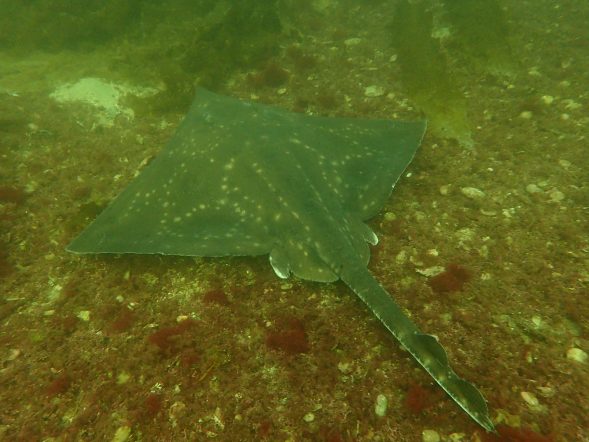
Skate © Chris Rickard
Underwater footage captured by a robot submarine off the west coast of Scotland has identified an important nursery ground for one of the world’s critically endangered fish, the flapper skate.
The remotely operated vehicle was used to explore an area of rocky seabed in Loch Melfort, Argyll, where it recorded video of 20 flapper skate egg cases – also known as mermaid’s purses – cradled between boulders on the seafloor.
It’s the first time an egg-laying site for the species has been pinpointed using drone technology and only the second such area confirmed in seas around the Scottish mainland to date.
The surveys were carried out by environmental charity and campaign group Open Seas.
The newly discovered egg-laying site is located in the Loch Sunart to Sound of Jura marine protected area, where dredging and trawling are banned. The findings in Loch Melfort follow the discovery by local divers and fishermen of a similar egg-laying site in the Inner Sound of Skye, which has also been designated a marine protected area.
Clam Cam
Conservationists have welcomed the finding, saying it proves the effectiveness of proper protection of important seabed habitats.
Chris Rickard, essential fish habitat officer for open Seas, said: “We knew they had been historically recorded in the area, but for something as small and well-camouflaged as a flapper purse, it can be like searching for a needle in a haystack.
“The drone, which we have nicknamed the Clam Cam, was able to cover a lot of ground safely and quickly. These fragile eggs are nestled on the seafloor for almost 18 months, so it’s vital that they are left undisturbed during this time. Thankfully bottom-trawling and dredging are banned in this area, but most of our coastal seas are open to these methods of fishing.”
Flapper Skate
Once common across the North East Atlantic, the flapper skate is now rare across much of its former range. However, a few strongholds remain in Scotland’s inshore waters. Scientists have sought to map their distribution in recent years to help promote recovery of the species.
The fish, which can grow to nearly 3m long, are known to spawn in coastal areas. Their egg cases take approximately 18 months to hatch, making them vulnerable to being caught or damaged by fishing gears.
The area has been protected from damaging activity such as bottom-trawling and dredging since 2009 and was designated as a marine protected area for the flapper skate in 2014.
Phil Taylor, head of policy and operations for Open Seas, said: “This is a fantastic find and demonstrates the power and purpose of marine protected areas. It shows just how vibrant our seas can be if given a chance. The world is in the grip of a biodiversity crisis, but the potential for our marine ecosystems to recover is incredible. Very often that just means protecting them from the most industrialised and extractive industries.”
“The world is in the grip of a biodiversity crisis, but the potential for our marine ecosystems to recover is incredible. Very often that just means protecting them from the most industrialised and extractive industries. Unfortunately, most of our sea does not receive such protection. As we have seen in Loch Melfort, the coastal seabed is the cradle of a healthy marine ecosystem. It’s vital we do much more to protect it.”
This article was originally published as Clam cam footage reveals important Scottish nursery ground for endangered fish at The Scotsman.